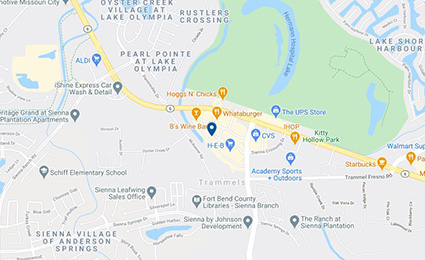UTHealth Houston Team Completes Feasibility Study for Minimally Invasive Myelomeningocele Repair in 25 Patients
More than a decade of research at McGovern Medical School at UTHealth Houston and The Fetal Center at Children’s Memorial Hermann Hospital led to the development of a watertight human umbilical cord (HUC) patch for fetoscopic myelomeningocele repair of small defects. Results of a pilot study of 25 patients, led by Ramesha Papanna, MD, MPH, a professor of maternal-fetal medicine, were promising and led to approval by the U.S. Food and Drug Administration to expand the trial to 25 more patients. Papanna is internationally recognized for his research on improving outcomes following fetal intervention and investigating methods for the prevention of preterm delivery.
“We have been studying successful surgical closure of the spina bifida defect with a special patch that approximates native tissue and allows for natural growth of the spinal cord,” Papanna says. “The procedure differs from in-utero repair, which requires a large incision on the uterus and delivery by cesarean section. Instead, we repair the spina bifida defect in two layers through three ports in the uterus using a NEOX® Cord 1K patch as a meningeal patch placed over the spinal cord, followed by a second layer of primary closure of the skin. Mothers undergo vaginal delivery, unless there is an obstetrical indication for delivery by C-section.”
 The NEOX Cord 1K patch is cryopreserved human umbilical cord and amniotic membrane manufactured by devitalizing all living cells while retaining the extracellular matrix and growth factors/cytokines within. It was developed by Amniox Medical, Inc., a subsidiary of TissueTech, Inc., a biotechnology company in Florida. Extensive laboratory and clinical research on a number of ocular indications has shown that birth tissue that includes amniotic membrane and umbilical cord helps manage inflammation in wounds, facilitates cell proliferation, and creates an environment for tissue regeneration.
The NEOX Cord 1K patch is cryopreserved human umbilical cord and amniotic membrane manufactured by devitalizing all living cells while retaining the extracellular matrix and growth factors/cytokines within. It was developed by Amniox Medical, Inc., a subsidiary of TissueTech, Inc., a biotechnology company in Florida. Extensive laboratory and clinical research on a number of ocular indications has shown that birth tissue that includes amniotic membrane and umbilical cord helps manage inflammation in wounds, facilitates cell proliferation, and creates an environment for tissue regeneration.
“Cryopreserved HUC has a regenerative matrix with anti-inflammatory and anti-scarring properties, which regenerates the arachnoid layer and improves spinal cord function,” Papanna says. “In our study, there was no cerebrospinal fluid leakage in the fetoscopic HUC repair cases compared to 5% in the open myelomeningocele repair group. We concluded that fetoscopic repair using the HUC as a meningeal patch is feasible, with comparable short-term outcomes compared to open in-utero repair. Vaginal delivery was possible in the majority of fetoscopically repaired patients. We hope our research is changing the way we approach spina bifida to improve closure, reduce scar tissue formation, reduce neurological deficits, and improve long-term outcomes.”
“Dr. Papanna is a workhorse for UTHealth Houston and our efforts to further research in a very fast-moving and competitive field,” says pediatric neurosurgeon Stephen A. Fletcher, DO, a professor in the Department of Pediatric Surgery. Early results of the study with 25 participants were published in January in the American Journal of Obstetrics1 and presented in February at the Society for Maternal-Fetal Medicine’s 43rd Annual Pregnancy Meeting held in San Francisco.
The research team is finalizing results of the second cohort of 25 patients and hope to move forward with a Phase 3 single pivotal study of the efficacy of fetoscopic repair with the HUC patch.
1Papanna R, Fletcher SA, Mann L, Garnett J, Bergh EP, Austin M, Miller B, Refuerzo J, Johnson A, Jain R, Tsao K. Fetoscopic myelomeningocele (fMMC) repair with human umbilical cord (fMMC-HUC) compared with open in-utero MMC repair (oMMC). Am J Obstet Gynecol. 2023 Jan;228(1):S44.
Inside this Edition:
- Responsive Neurostimulation for Generalized Epilepsy in an 18-Year-Old
- The NICU Follow-Up Clinic: Everything Premature Babies Need To Get the Best Start in Life
- Team-Based Medicine Leads to Nonsurgical Repair of Depressed Skull Fractures in Two Neonates
- Watchful Waiting for Cerebral Venous Thrombosis Allows a Boy To Avoid Brain Surgery
- UTHealth Houston Team Completes Feasibility Study for Minimally Invasive Myelomeningocele Repair in 25 Patients
- Developing Better Laboratory Models of Neonatal Intraventricular Hemorrhage and Hydrocephalus
- Researchers Seek to Improve Outcomes in Children with Malignant Fourth Ventricular Brain Tumors Through Novel Studies
- McGovern Medical School Alumni Blend Neurology Expertise and Philanthropy To Advance Pediatric Tumor Research











